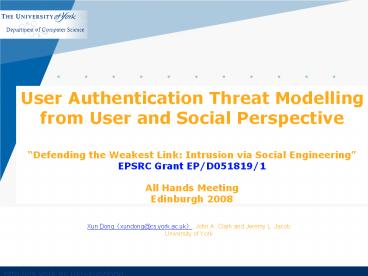User Authentication Threat Modelling from User and Social Perspective - PowerPoint PPT Presentation
1 / 14
Title:
User Authentication Threat Modelling from User and Social Perspective
Description:
User Authentication Threat Modelling from User and Social Perspective 'Defending the Weakest Link: ... even rubbish bin contents). Many are launched by ... – PowerPoint PPT presentation
Number of Views:26
Avg rating:3.0/5.0
Title: User Authentication Threat Modelling from User and Social Perspective
1
User Authentication Threat Modelling from User
and Social PerspectiveDefending the Weakest
Link Intrusion via Social Engineering EPSRC
Grant EP/D051819/1All Hands Meeting Edinburgh
2008
- Xun Dong(xundong_at_cs.york.ac.uk), John A. Clark
and Jeremy L. Jacob - University of York
2
Motivation Attacking Trend Shift
- Grid users may become the focus of attack
- The technical barrier to hack the systems has
been increased significantly protection for
users is less well developed. - Valuable information such as authentication
credentials sought by attackers are possessed by
users as well. - Many system designs do not help the general user
to achieve security goals. - Existing threat modelling techniques do not deal
with users (though general purpose e.g.
Microsofts TM, and various domain specific
threat modelling techniques and models have been
developed) - The complexity of identifying user side
vulnerabilities is significant, however, there is
no method designers can rely on.
3
Simple Attack Taxonomy
- Passive attacks
- They do not require active victim involvement,
often - achieving their goal by analysing information
available to - attackers (e.g. that from public databases or
websites, or - even rubbish bin contents). Many are launched by
- insiders or people who have close relationships
with the - victims.
- Active attacks
- They exploit the users difficulty in
authenticating External Entities (EEs),
requesting the users authentication credentials
whilst posing as trustworthy parties. Typical
examples are phishing and pharming attacks.
4
Overview
5
Dependency Relationships
- The authentication systems may be designed and
implemented independently, but the choices of the
user authentication credentials may connect
different systems into complex and unpredictable
networks. - Examples Access to an secondary email account is
used to recover/reset the password. - Institutional photo ID such as student card
is accepted as authentication credentials to
prove ones identity.
6
Dependency Relationships
- Compromise of the security of the current
- authentication system
- The security of the current system is equal to
the security of the weakest system reachable in
the graph. - Obtaining authentication credentials to the
weakest system propagates access back up the
chain.
7
Dependency Relationships
- Identify its existence by the properties of user
authentication - credentials
- users have access to
- assigned by third parties
- Represent them in graph
- Three Components in the graph
- Node represents a system
- Directed Edges an edge from Node A to Node B
means Node A depends on Node B. - Special symbol R Represent random systems,
and edge towards R from Node A means the system
which A is depends on is unpredictable. - The start node of the graph is the system being
designed.
8
Impersonating Targets
- May be wider than the system being considered
- the entities that the user has shared
authentication credentials with - the entities that are entitled to request users
authentication credentials or initiate user-to-EE
authentication - and the entities that exist in the authentication
dependency graph.
9
Lifecycle of Authentication Credentials
10
Attack Entry Points
- Active attacks can only obtain users
authentication - credentials when they are exchanged. By using the
lifecycle - analysts can identify in which states and in
which transitions - this occurs
- Synchronisation State
- Operation State
- State transition from operation to assignment
- State transition from operation to
synchronisation - State transition from suspension to assignment
- State transition from suspension to operation.
11
Entry Points Analysis
- Reliability and Sufficiency of Authentication
Information The successful EE-to-user
authentication users must have reliable and
sufficient authentication credentials. - Knowledge Users need both technical and
contextual knowledge to decide whether to release
the credentials requested by an external entity. - Assumptions The security of EE-to-user
authentication depends on the strength of the
assumption on users can perform certain required
actions correctly and consistently.
12
Communication Channels (CC)
- Active attacks need to engage user victims on a
- communication channel, and the trust,
expectation - and perception constructed in communications
- could reduce users ability to authenticate the
EE - in the following authentication session.
- Analysts should identify and analyse the
- vulnerabilities within the CC with the same
method - as used in analysis for the attack entry points.
13
Conclusion
- Userside threat modelling is as important as
systemside threat modelling, but it is much less
well studied. - Our method is an initial effort towards
developing a threat modelling method that can be
used by system designers with moderate security
knowledge. - Your suggestions are appreciated.
An extended version will be delivered at ICICS
2008 Birmingham 20-22 October 2008
14
- Questions Answers
- If you have a system that would like us to study,
we are very happy to hear from you!
Defending the Weakest LinkIntrusion via Social
Engineering EPSRC Grant EP/D051819/1































